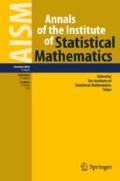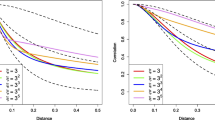Abstract
We consider spatially homogeneous copulas, i.e. copulas whose corresponding measure is invariant under a special transformations of \([0,1]^2\), and we study their main properties with a view to possible use in stochastic models. Specifically, we express any spatially homogeneous copula in terms of a probability measure on [0, 1) via the Markov kernel representation. Moreover, we prove some symmetry properties and demonstrate how spatially homogeneous copulas can be used in order to construct copulas with surprisingly singular properties. Finally, a generalization of spatially homogeneous copulas to the so-called (m, n)-spatially homogeneous copulas is studied and a characterization of this new family of copulas in terms of the Markov \(*\)-product is established.




Similar content being viewed by others
References
Alfonsi, A., Brigo, D. (2005). New families of copulas based on periodic functions. Communications in Statistics Theory and Methods, 34(7), 1437–1447.
Ambrosio, L., Fusco, N., Pallara, D. (2000). Functions of bounded variation and free discontinuity problems. New York: The Clarendon Press, Oxford University Press.
Brown, J. R. (1965). Doubly stochastic measures and Markov operators. The Michigan Mathematical Journal, 12, 367–375.
Brown, J. R. (1966). Spatially homogeneous Markov operators. Zeitschrift für Wahrscheinlichkeitstheorie und Verwandte Gebiete, 6(4), 279–286.
Darsow, W. F., Nguyen, B., Olsen, E. T. (1992). Copulas and Markov processes. Illinois Journal of Mathematics, 36(4), 600–642.
Durante, F., Sempi, C. (2016). Principles of Copula Theory. Boca Raton, FL: CRC Press.
Durante, F., Fernández-Sánchez, J., Trutschnig, W. (2015). A typical copula is singular. Journal of Mathematical Analysis and Applications, 430, 517–527.
Falconer, K. (2014). Mathematical foundations and applications. Fractal geometry (3rd ed.). Chichester: Wiley.
Fernández-Sánchez, J., Trutschnig, W. (2015). Conditioning-based metrics on the space of multivariate copulas and their interrelation with uniform and levelwise convergence and iterated function systems. Journal of Theoretical Probability, 28(4), 1311–1336.
Fernández-Sánchez, J., Trutschnig, W. (2016). Some members of the class of (quasi-)copulas with given diagonal from the Markov kernel perspective. Communications in Statistics Theory and Methods, 45, 1508–1526.
Fredricks, G. A., Nelsen, R. B., Rodríguez-Lallena, J. A. (2005). Copulas with fractal supports. Insurance: Mathematics & Economics, 37(1), 42–48.
Jones, M. C., Pewsey, S., Kato, A. (2015). On a class of circulas: Copulas for circular distributions. Annals of the Institute of Statistical Mathematics, 67(5), 843–862.
Klenke, A. (2008). Probability theory. A comprehensive course. Berlin: Springer.
Kunze, H., La Torre, D., Mendivil, F., Vrscay, E. R. (2012). Fractal-based methods in analysis. New York: Springer.
Lange, K. (1973). Decompositions of substochastic transition functions. Proceedings of the American Mathematical Society, 37, 575–580.
Mikusiński, P., Taylor, M. D. (2009). Markov operators and \(n\)-copulas. Annales Polonici Mathematici, 96(1), 75–95.
Mikusiński, P., Taylor, M. D. (2010). Some approximations of \(n\)-copulas. Metrika, 72(3), 385–414.
Nelsen, R. B. (2006). An introduction to copulas (2nd ed.). Springer series in statistics. New York: Springer.
Olsen, E. T., Darsow, W. F., Nguyen, B. (1996). Copulas and Markov operators. In L. Rüschendorf, B. Schweizer, M. Taylor (eds.), Proceedings of the AMS-IMS-SIAM joint summer research conference on distributions with fixed marginals, doubly stochastic measures and Markov operators held in Seattle, WA, August 1–5, 1993, IMS lecture notes monograph series, volume 28 (pp. 244–259). Institute of Mathematical Statistics, Hayward, CA.
Phelps, R. R. (2001). Lectures on Choquet’s theorem. Lecture notes in mathematics (Vol. 1757, 2nd ed.). Berlin: Springer.
Segers, J. (2012). Asymptotics of empirical copula processes under non-restrictive smoothness assumptions. Bernoulli, 18(3), 764–782.
Stromberg, K. (1972). An elementary proof of Steinhaus’s theorem. Proceedings of the American Mathematical Society, 36, 308.
Tao, T. (2011). An introduction to measure theory, graduate studies in mathematics, Vol. 126. Providence, RI: American Mathematical Society.
Trutschnig, W. (2011). On a strong metric on the space of copulas and its induced dependence measure. Journal of Mathematical Analysis and Applications, 384(2), 690–705.
Trutschnig, W. (2013). On Cesáro convergence of iterates of the star product of copulas. Statistics & Probability Letters, 83(1), 357–365.
Trutschnig, W., Fernández Sánchez, J. (2012). Idempotent and multivariate copulas with fractal support. Journal of Statistical Planning and Inference, 142(12), 3086–3096.
Trutschnig, W., Fernández Sánchez, J. (2014). Copulas with continuous, strictly increasing singular conditional distribution functions. Journal of Mathematical Analysis and Applications, 410(2), 1014–1027.
Acknowledgements
The authors gratefully acknowledge the support of the grant MTM2014-60594-P (partially supported by FEDER) from the Spanish Ministry of Economy and Competitiveness. The first author has been partially supported by INdAM–GNAMPA Project 2017 “Bounds for Risk Functionals in Dependence Models”.
Author information
Authors and Affiliations
Corresponding author
About this article
Cite this article
Durante, F., Fernández Sánchez, J. & Trutschnig, W. Spatially homogeneous copulas. Ann Inst Stat Math 72, 607–626 (2020). https://doi.org/10.1007/s10463-018-0703-8
Received:
Revised:
Published:
Issue Date:
DOI: https://doi.org/10.1007/s10463-018-0703-8




